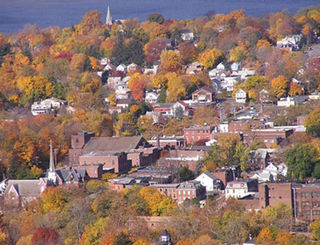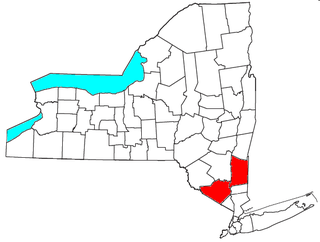
Dutchess County is a county in the U.S. state of New York. As of the 2020 census, the population was 295,911. The county seat is the city of Poughkeepsie. The county was created in 1683, one of New York's first twelve counties, and later organized in 1713. It is located in the Mid-Hudson Region of the Hudson Valley, north of New York City.

Beacon is a city located in Dutchess County, New York, United States. The 2020 census placed the city total population at 13,769. Beacon is part of the Poughkeepsie–Newburgh–Middletown, New York Metropolitan Statistical Area as well as the larger New York–Newark–Bridgeport, New York–New Jersey–Connecticut–Pennsylvania Combined Statistical Area.

Wappinger, officially the Town of Wappinger, is a town in Dutchess County, New York, United States. The town is located in the Hudson River Valley region, approximately 60 miles (97 km) north of Midtown Manhattan, on the eastern bank of the Hudson River. The population was 28,216 at the 2020 census. The name is derived from the Wappinger Native Americans who inhabited the area. Wappinger comprises three-fourths of the incorporated Village of Wappingers Falls, several unincorporated hamlets such as Chelsea, Diddell, Hughsonville, Middlebush, Myers Corners, New Hackensack, and Swartwoutville, and a number of neighborhoods.

Wappingers Falls is a village in Dutchess County, New York, United States. As of the 2010 census it had a population of 5,522. The community was named for the cascade in Wappinger Creek. The Wappingers Falls post office covers areas in the towns of Wappinger, Poughkeepsie, Fishkill, East Fishkill, and LaGrange. This can result in some confusion when residents of the outlying towns, who do not live in the village, give their address as "Wappingers Falls".

Fishkill is a village within the town of Fishkill in Dutchess County, New York, United States. The village is in the eastern part of the town of Fishkill on U.S. Route 9. It is north of Interstate 84. NY 52 is the main street. It is part of the Poughkeepsie–Newburgh–Middletown, NY Metropolitan Statistical Area as well as the larger New York–Newark–Bridgeport, NY-NJ-CT-PA Combined Statistical Area. The first U. S. Post Office in New York state was established in Fishkill by Samuel Loudon, its first Postmaster.

Fishkill is a town in the southwestern part of Dutchess County, New York, United States. It lies approximately 60 miles (97 km) north of New York City. The population was 22,107 at the 2010 census. Fishkill surrounds the city of Beacon, and contains a village, which is also named Fishkill.

Poughkeepsie, officially the Town of Poughkeepsie, is a town in Dutchess County, New York, United States. As of the 2020 United States Census, the population was 45,471. The name is derived from the native term Uppuqui meaning "lodge-covered", plus ipis meaning "little water", plus ing meaning "place", all of which translates to "the reed-covered lodge by the little water place", or Uppuqui-ipis-ing. This later evolved into Apokeepsing, then into Poughkeepsing, and finally Poughkeepsie.
New Hamburg is a small hamlet along the Hudson River in Dutchess County, New York, United States. It is located in the southern corner of the Town Of Poughkeepsie.
New York State Route 9D (NY 9D) is a north–south state highway in the Hudson Valley region of New York in the United States. It starts at the eastern end of the Bear Mountain Bridge at an intersection with U.S. Route 6 (US 6) and US 202 in Westchester County, and follows the eastern shore of the Hudson River for 25.21 miles (40.57 km) to a junction with US 9 north of the village of Wappingers Falls in Dutchess County. While US 9 follows a more inland routing between the bridge and Wappingers Falls, the riverside course of NY 9D takes the route through the village of Cold Spring and the city of Beacon.

Dutchess Mall was an enclosed shopping mall in Fishkill, New York. The mall was demolished and replaced with a Home Depot except for the Jamesway and Service Merchandise buildings. The former Service Merchandise building was home to a flea market until the mid-2000s but now sits vacant and empty. At some point in the mid-2000s, the Dutchess Marketplace Flea Market move to the former Jamesway building, although it closed at the end of 2019. A new campus for Dutchess Community College moved into the Jamesway space and opened in August 2021. Dagar Group manages the shopping area. R.C. Chera Realty Group is the exclusive leasing broker for the existing vacant structure.

The U.S. Post Office in Beacon, New York, is located on Main Street. It serves the ZIP Code 12508, covering the entire city of Beacon and some of the neighboring areas of the Town of Fishkill. It is a stone structure in the Dutch Colonial Revival architectural style built in the mid-1930s. In 1988 it was listed on the National Register of Historic Places along with many other older post offices in the state.

The U.S. Post Office in Rhinebeck, New York serves the 12572 ZIP Code. It is located on Mill Street just south of the intersection with NY 308 at the center of the village.

Formerly the Wappingers Falls Village Hall this building now houses the Police Department. It is located at the corner of South Avenue and East Main Street in the village of Wappingers Falls, Dutchess County, New York.

Chelsea is a hamlet of the Town of Wappinger in Dutchess County, New York, United States. It is located on the Hudson River in the southwestern corner of the town. It takes the ZIP Code 12512 and is in the 845 telephone area code, and has its own fire district.

The Poughkeepsie–Newburgh–Middletown Metropolitan Statistical Area, as defined by the United States Census Bureau, is an area consisting of two counties in New York's Hudson Valley, with the cities of Poughkeepsie, Newburgh, and Middletown as its principal cities. As of the 2020 census, the MSA had a population of 679,221 The area was centered on the urban area of Poughkeepsie-Newburgh.
Wheeler Hill Historic District is a federally recognized historic district located at Wappinger in Dutchess County, New York. Along the eastern shore of the Hudson River, atop of the Van Wyck Ridge is the "estates region of the Town of Wappinger". A scenic location, with roads lined with stone walls, properties greeting guests with magnificent stone pillars and iron gates, it includes 49 contributing buildings, 15 contributing sites, and four contributing structures. It encompasses the estates of Obercreek, Elmhurst, Edge Hill, Henry Suydam, William Crosby, and Carnwath that were developed between 1740 and 1940. Also included are two 18th century riverfront commercial structures, the Lent / Waldron Store and Stone House at Farmer's Landing. It was added to the National Register of Historic Places in 1991. Today the historic district is mostly made up of residential houses, but Carnwath and Obercreek are opened to the public.
St. Denis Church is a Roman Catholic parish church under the authority of the Roman Catholic Archdiocese of New York, located in Hopewell Junction, Dutchess County, New York. It was established in 1899 as a parish; it was established a mission of St. Mary in Wappingers Falls in 1874 until being elevated in a parish in 1899.
The Church of St. Mary is a Roman Catholic parish church under the authority of the Roman Catholic Archdiocese of New York, located in Wappingers Falls, Dutchess County, New York. It was canonically established in 1845.
The Church of St. Joachim and St. John the Evangelist is a Roman Catholic parish church under the authority of the Roman Catholic Archdiocese of New York, located in Beacon, Dutchess County, New York. It was established after a parish mergers of the Church of St. Joachim, and St. John the Evangelist. The merged parishes share a pastor, clergy and administrative staff, and the two church buildings continued to be used for worship.
Wappingers Central School District (WCSD) is a school district headquartered in the town of East Fishkill, New York, on Corporate Park Drive.


















